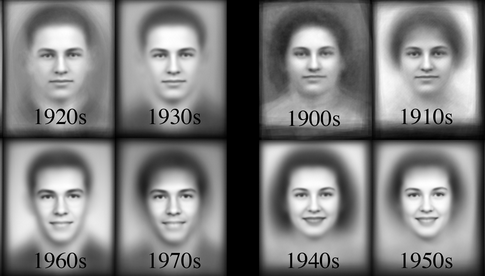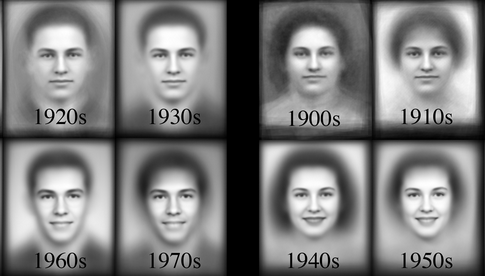Say Cheese: Yearkbook Photos Show How Our Smiles Have Changed In The Last 100 Years

We’re often told to loosen up and say "cheese” as we crack our widest smile for the camera. However, taking a photo wasn’t always about flashing our best smile, according to researchers at UC Berkeley, who sifted through yearbook photos to determine how the photographic smile has evolved over the last century.
"Yearbooks are a cool set of data as they give us kind of a 'peephole' into the past where everything — pose, the reason for taking the picture, the age of the subjects, etc. — remains constant, except for the passing time," Shiry Ginosar, lead author of the study and a PhD student at UC Berkeley, told FairFox Media.
Ginosar and her team looked at about 38,000 portraits taken between 1905 and 2013 for over 800 yearbooks from high schools in 26 states. The photos were sorted by gender, and then each decade's images were combined to create an "average" male and female face, which revealed features for the time period, such as hair, clothing, and facial expressions.
One thing that stood out in particular were people's smiles. The researchers were able to quantify the intensity of smiles by measuring lip curvature. The “smile intensity metric” found smiling has consistently increased over time. Men began the century with a -0.5-degree lip curvature, otherwise known as a slight frown, and by 2005 they had moved up to a 9.5-degree curvature. Women, meanwhile, started the century with a 1.20-degree curvature, and have since reached a 13.50-degree curvature.
The shift in lip curvature is attributed to people’s photo posing habits throughout the years. In the late 19th century, people adopted the same habits as people posing for painted portraits. A serious expression was easier to maintain for the duration of time it took to complete the painting. “Also, etiquette and beauty standards dictated that the mouth be kept small — resulting in an instruction to 'say prunes' when a photograph was being taken,” wrote the researchers in the report.

So, when it comes to gender, have women always smiled more than men?
A similar 2003 study found women do smile more than men, depending on the circumstance. The largest differences in smiling occurred when men and women thought they were being observed, while smiles were more similar when no one was looking. The researchers suggest when people know their behavior is being monitored, they will adhere to behavior that reflects their gender norms. This offers a possible explanation for why men smile differently than women in high school yearbook photos.
Aside from smiles, the researchers were able to show the "quintessential styles of each decade," like the types of hairstyles and glasses students wore. Hairstyle trends included finger waves in the 30s, bouffants and afros in the 70s, and long, straight hair in the 2000s. The research team hopes to use the dataset to study things like "the cycle-length of fashion fads."
The researchers cautioned, however, that their study had one limitation in its data set. The number of Americans graduating from high school increased by more than 40 percent between 1900 and 1960, and the African American population was not represented until the mid-20th century. On the other hand, the study did prove photos can be mined for data without the manual effort of the past. Now, that’s something worth smiling about.
Sources: Ginosar S, Rakelly K, Sachs S et al. A Century of Portraits: A Visual Historical Record of American High School Yearbooks. Extreme Imaging Workshop, International Conference on Computer Vision, ICCV 2015.
LaFrance M, Hecht MA, Paluck EL. The contingent smile: a meta-analysis of sex differences in smiling. Psychological Bulletin. 2003.
Published by Medicaldaily.com



























